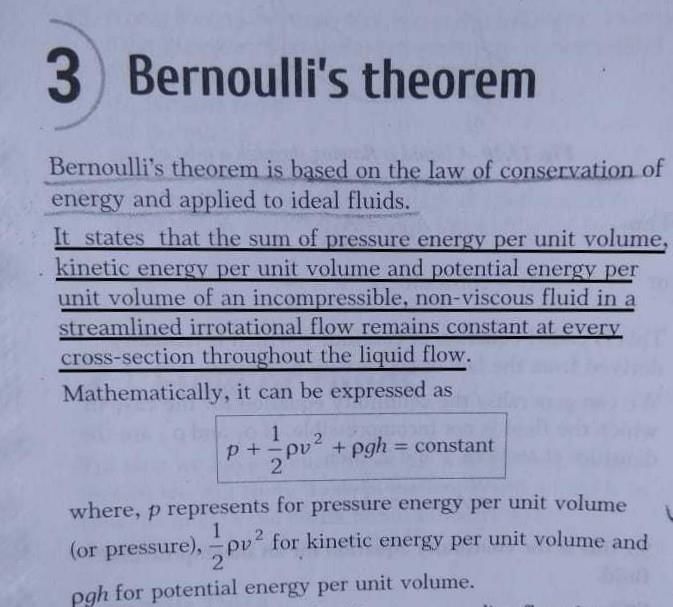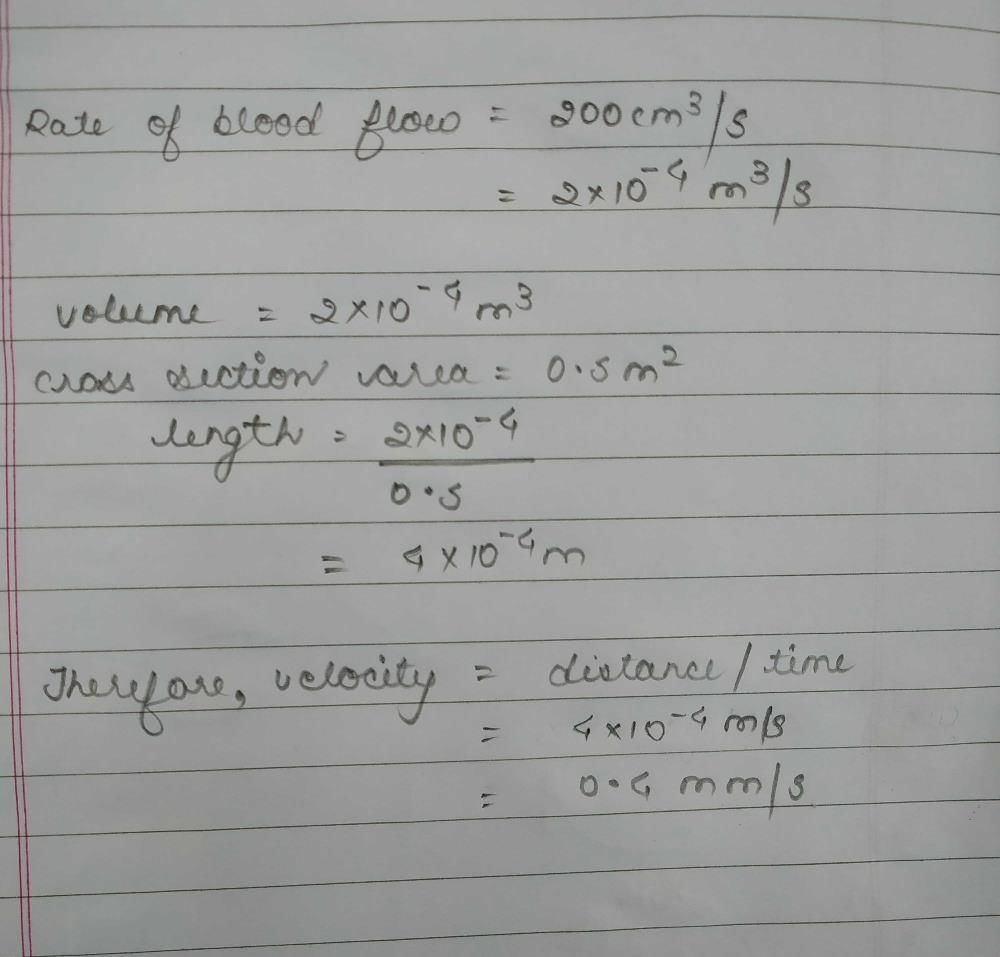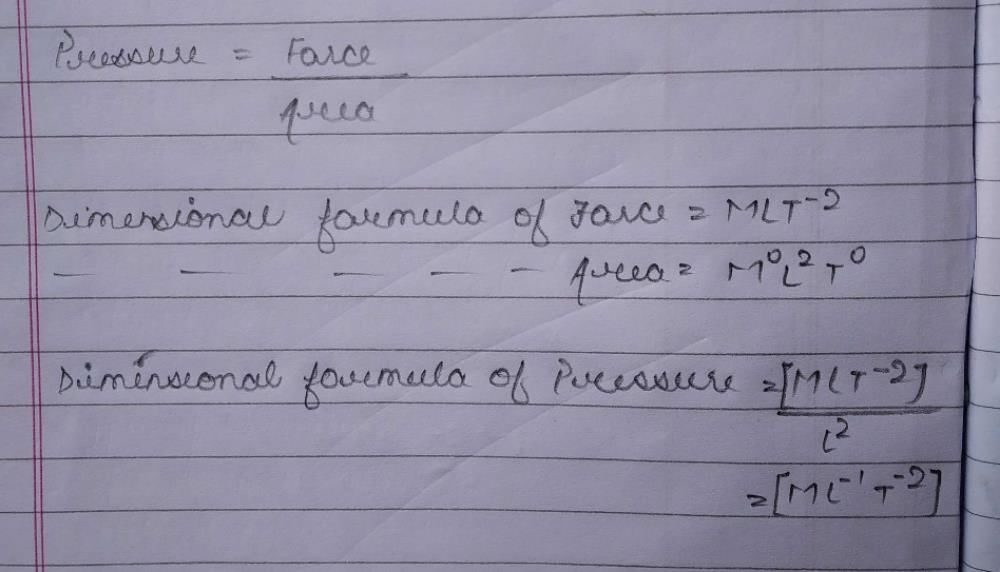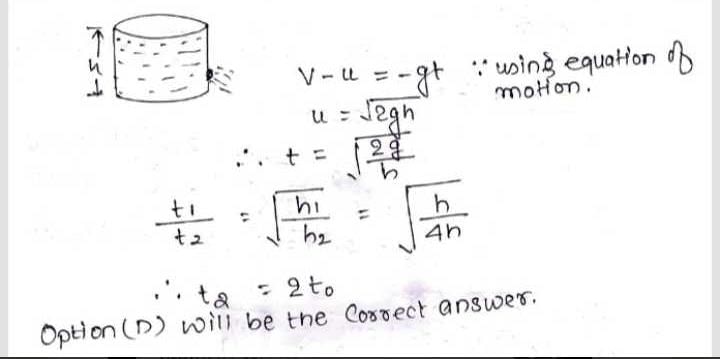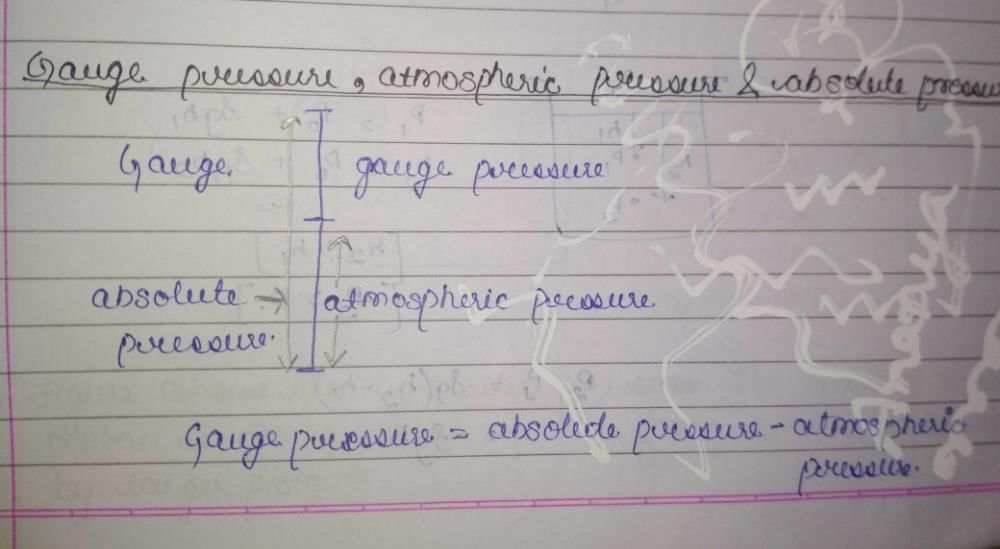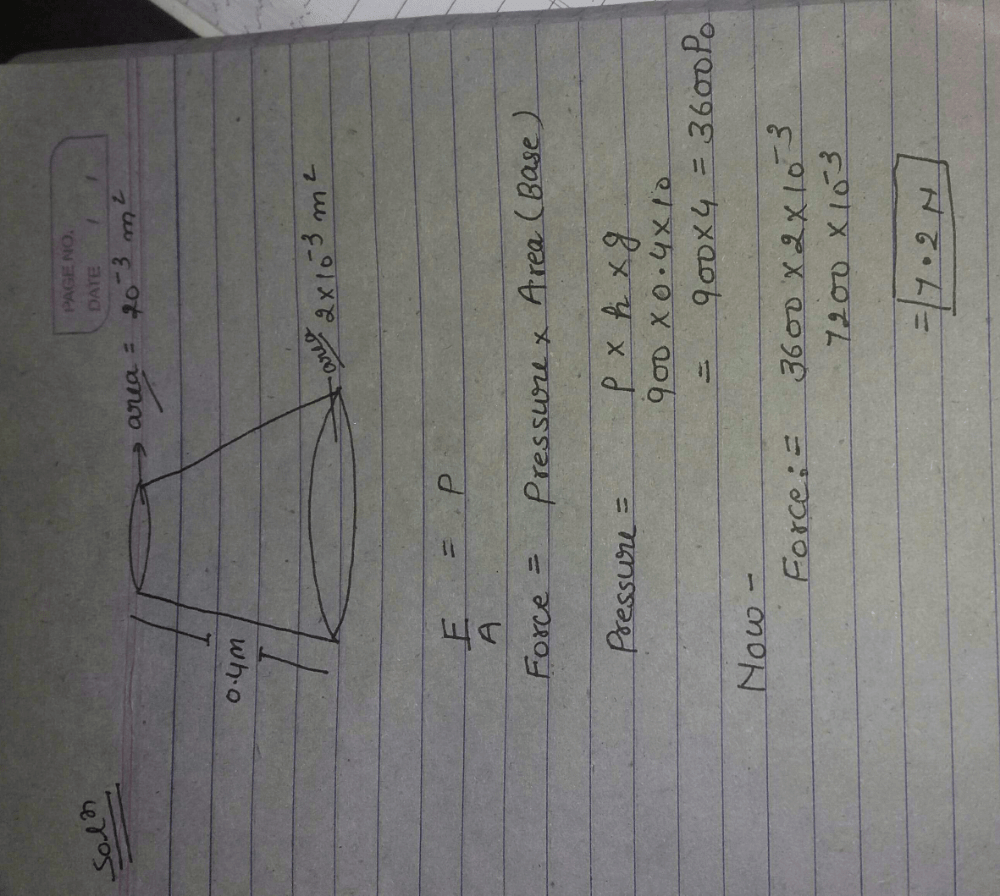All Exams >
Grade 11 >
Physics for Grade 11 >
All Questions
All questions of Mechanical Properties of Fluids for Grade 11 Exam
The formula used to find the pressure on a swimmer h metres below the surface of a lake is: (where Pa is the atmospheric pressure.)- a)Pa +hρ
- b)hρg
- c)Pa - hρg
- d)Pa + hρg
Correct answer is option 'D'. Can you explain this answer?
The formula used to find the pressure on a swimmer h metres below the surface of a lake is: (where Pa is the atmospheric pressure.)
a)
Pa +hρ
b)
hρg
c)
Pa - hρg
d)
Pa + hρg
|
|
Pooja Shah answered |
We know that the pressure at some point inside the water can be represented by: Pa + ρhg
where,
ρ = Density of the liquid
Pa = Atmospheric pressure
H = Depth at which the body is present
g = Gravitational acceleration
where,
ρ = Density of the liquid
Pa = Atmospheric pressure
H = Depth at which the body is present
g = Gravitational acceleration
Two vessels with equal base and unequal height have water filled to same height. The force at the base of the vessels is
- a)Force doesn’t depend on such factors
- b)Equal
- c)varies with time
- d)Unequal
Correct answer is option 'B'. Can you explain this answer?
Two vessels with equal base and unequal height have water filled to same height. The force at the base of the vessels is
a)
Force doesn’t depend on such factors
b)
Equal
c)
varies with time
d)
Unequal
|
|
Preeti Iyer answered |
Two vessels having the same base area have identical force and equal pressure acting on their common base area. Since the shapes of the two vessels are different, the force exerted on the sides of the vessels has non-zero vertical components. When these vertical components are added, the total force on one vessel comes out to be greater than that on the other vessel. Hence, when these vessels are filled with water to the same height, they give different readings on a weighing scale.
The angle of contact for the liquid which wets the walls of the vessel is- a)acute
- b)zero
- c)obtuse
- d)900
Correct answer is option 'A'. Can you explain this answer?
The angle of contact for the liquid which wets the walls of the vessel is
a)
acute
b)
zero
c)
obtuse
d)
900
|
|
Anjana Sharma answered |
When liquid molecules are attracted strongly to themselves and weakly to those of solids, it costs lots of energy to create liquid-solid surface and liquid then does not wet the solid.
For Example:
Mercury molecules (which make an obtuse angle with glass) have a strong force of attraction between themselves and a weak force of attraction toward solids. Hence, they tend to form drops.
On the other hand, water molecules make acute angles with glass. They have a weak force of attraction between themselves and a strong force of attraction toward solids. Hence, they tend to spread out.
Find the density when a liquid 5 m high in a column exerts a pressure of 80 Pa- a)625 kg/m3
- b)1.6 kg/m3
- c)0.625 kg/m3
- d)2.625 kg/m3
Correct answer is option 'C'. Can you explain this answer?
Find the density when a liquid 5 m high in a column exerts a pressure of 80 Pa
a)
625 kg/m3
b)
1.6 kg/m3
c)
0.625 kg/m3
d)
2.625 kg/m3
|
|
Suresh Iyer answered |
► Pressure = Density x Gravity x Height = ρgh
⇒ ρ = P/(g*h) = 80 Pa / (9.8 m/s2 x 5 m)
⇒ Density = 1.632 kg/m3
⇒ ρ = P/(g*h) = 80 Pa / (9.8 m/s2 x 5 m)
⇒ Density = 1.632 kg/m3
A slender homogeneous rod of length 2L floats partly immersed in water, being supported by a string fastened to one of its ends, as shown. The specific gravity of the rod is 0.75. The length of rod that extends out of water is 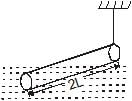
- a)L
- b)

- c)

- d)3L
Correct answer is option 'A'. Can you explain this answer?
A slender homogeneous rod of length 2L floats partly immersed in water, being supported by a string fastened to one of its ends, as shown. The specific gravity of the rod is 0.75. The length of rod that extends out of water is
a)
L
b)
c)
d)
3L
|
|
Preeti Khanna answered |
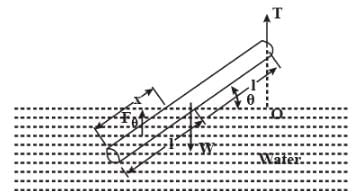
Let's say x length of the rod is dipped into the water.
Since the buoyant force acts through the centre of gravity the displaced water , the condition for rotational equilibrium is, taking moments about a point O along the line of action of T,
0=Στo
⇒0=wl cosθ−FB(2l−x/2)cosθ
⇒0=ρrodgA(2l)(lcosθ)−ρwatergAx(2l−x/2)cosθ
⇒0=(1/2ρwatergAcosθ) (x2−4lx+4 (ρrod/ρwater)l2) where A=cross section area
⇒x2−4lx+3l2=0
⇒x=l,3l.
x=3l is not a possible solution, hence 2l−x=2l−l=l length of the rod extends out of the water.
Water rises to a height of 20 mm in a capillary. If the radius of the capillary is made 1/3 rd of its previous value, to what height will the water now rise in the tube?- a)60 mm
- b)80 mm
- c)40 mm
- d)30 mm
Correct answer is option 'A'. Can you explain this answer?
Water rises to a height of 20 mm in a capillary. If the radius of the capillary is made 1/3 rd of its previous value, to what height will the water now rise in the tube?
a)
60 mm
b)
80 mm
c)
40 mm
d)
30 mm
|
|
Pooja Mehta answered |
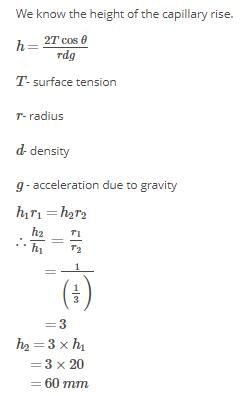
HENCE,CORRECT OPTION IS (A).
The surface tension of a soap solution is 0.05 Nm-1. How much work is done to produce a soap bubble of radius 0.03 m?- a)1.8 x 10-2 J
- b)2.1 x 10-3J
- c)1.5 x 10-2 J
- d)1.1 x 10-3 J
Correct answer is option 'D'. Can you explain this answer?
The surface tension of a soap solution is 0.05 Nm-1. How much work is done to produce a soap bubble of radius 0.03 m?
a)
1.8 x 10-2 J
b)
2.1 x 10-3J
c)
1.5 x 10-2 J
d)
1.1 x 10-3 J
|
|
Suresh Iyer answered |
Work done=total surface x Surface tension
=2x4πr2xσ
=2x4x3.14(0.03)2x 0.05
=1.1x10-3J
=2x4πr2xσ
=2x4x3.14(0.03)2x 0.05
=1.1x10-3J
Water is flowing through a pipe under constant pressure. At some place the pipe becomes narrow. The pressure of water at this place:- a)remains the same
- b)depends on several factors
- c)decreases
- d)increases
Correct answer is option 'C'. Can you explain this answer?
Water is flowing through a pipe under constant pressure. At some place the pipe becomes narrow. The pressure of water at this place:
a)
remains the same
b)
depends on several factors
c)
decreases
d)
increases
|
|
Suresh Iyer answered |
We know that the continuity theorem says that if the cross sectional area of the water flow decreases, the speed must increase to maintain the volume of water flown. And according to Bernoulli's principle if the speed of water flow increases , then the pressure must decrease.
Which of the following expression is true for surface tension?- a)σ = -F/1
- b)σ = F/1
- c)σ = F.1
- d)σ = F.1.A
Correct answer is option 'B'. Can you explain this answer?
Which of the following expression is true for surface tension?
a)
σ = -F/1
b)
σ = F/1
c)
σ = F.1
d)
σ = F.1.A
|
|
Pooja Shah answered |
The force acting on this line is proportional to the length of this line. If l is the length of imaginary line and F the total force on either side of the line then,
F∝l
⇒ F=Sl
Or, surface tension, S=force/length
From this expression, Surface tension can be defined as the force acting per unit length of an imaginary line drawn on the liquid surface, the direction of force being perpendicular to this line and tangential to the liquid surface.it is denoted by S and it is a scalar quantity.
F∝l
⇒ F=Sl
Or, surface tension, S=force/length
From this expression, Surface tension can be defined as the force acting per unit length of an imaginary line drawn on the liquid surface, the direction of force being perpendicular to this line and tangential to the liquid surface.it is denoted by S and it is a scalar quantity.
A non-viscous liquid flows through a hose. Liquid enters with velocity 6.4 m/s and leaves with velocity 2.5 m/s. What is the ratio of radii of the hose where the liquid enters and where it leaves?
- a)5:1
- b)5:8
- c)8:5
- d)8:1
Correct answer is option 'B'. Can you explain this answer?
A non-viscous liquid flows through a hose. Liquid enters with velocity 6.4 m/s and leaves with velocity 2.5 m/s. What is the ratio of radii of the hose where the liquid enters and where it leaves?
a)
5:1
b)
5:8
c)
8:5
d)
8:1
|
|
Pavyasree D answered |
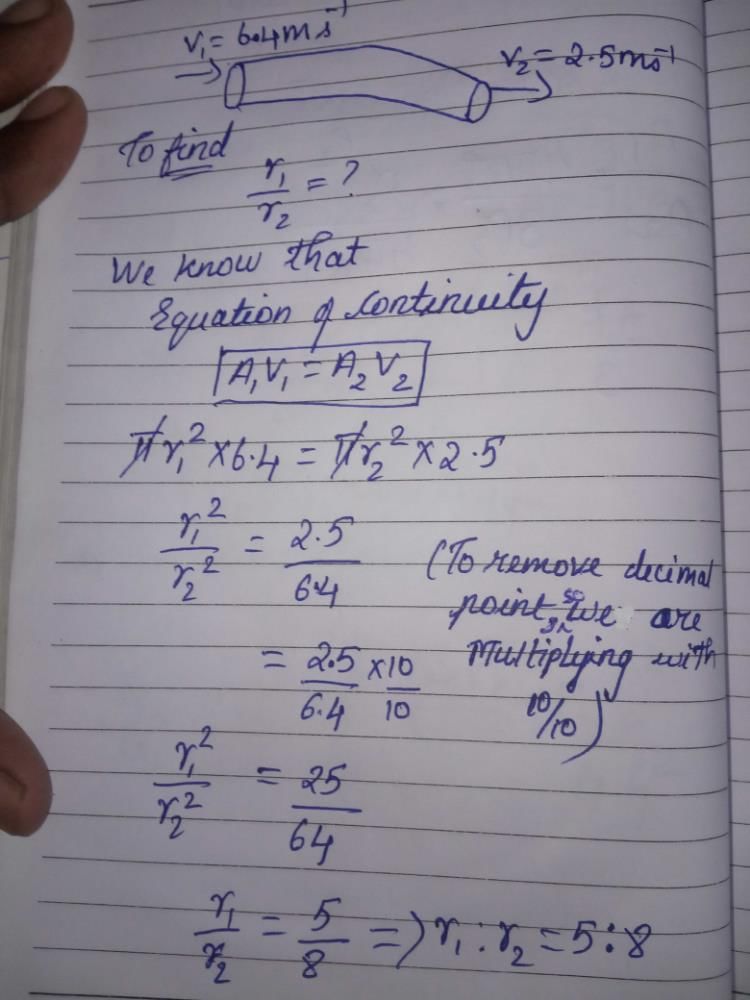
An open-ended U-tube of uniform cross-sectional area contains water (density 1.0 gram/centimeter3) standing initially 20 centimeters from the bottom in each arm. An immiscible liquid of density 4.0 grams/centimeter3 is added to one arm until a layer 5 centimeters high forms, as shown in the figure above. What is the ratio h2/h1 of the heights of the liquid in the two arms ? 
- a) 3/1
- b)5/2
- c)2/1
- d)3/2
Correct answer is option 'C'. Can you explain this answer?
An open-ended U-tube of uniform cross-sectional area contains water (density 1.0 gram/centimeter3) standing initially 20 centimeters from the bottom in each arm. An immiscible liquid of density 4.0 grams/centimeter3 is added to one arm until a layer 5 centimeters high forms, as shown in the figure above. What is the ratio h2/h1 of the heights of the liquid in the two arms ?
a)
3/1
b)
5/2
c)
2/1
d)
3/2

|
Ambition Institute answered |
5 × 4 × 10 + (h1 - 5) × 10 = h2 × 1 × 10
200 + 10h1 – 50 = 10h2
10h2 - 10h1 = 150
h2 - h1 = 15
h2 + h1 = 20 + 20 + 5 = 45
2h2 = 60
h2 = 30
h1 = 15
h2/h1 = 30/15
h2/h1 = 2/1
200 + 10h1 – 50 = 10h2
10h2 - 10h1 = 150
h2 - h1 = 15
h2 + h1 = 20 + 20 + 5 = 45
2h2 = 60
h2 = 30
h1 = 15
h2/h1 = 30/15
h2/h1 = 2/1
Hydraulic brakes use- a)Gas law
- b)Stoke’s Law
- c)Pascal’s Law
- d)Archimide’s Principle
Correct answer is option 'C'. Can you explain this answer?
Hydraulic brakes use
a)
Gas law
b)
Stoke’s Law
c)
Pascal’s Law
d)
Archimide’s Principle
|
|
Shreya Gupta answered |
Hydraulic Brakes
Hydraulic brakes work on the principle of Pascal’s law. According to this law whenever pressure is applied on a fluid it travels uniformly in all the directions.
Therefore when we apply force on a small piston, pressure gets created which is transmitted through the uid to a larger piston. As a result of this larger force,uniformbrakingis applied on all four wheels.
As braking force is generateddue to hydraulic pressure,theyare known as hydraulic brakes.
Liquids are used instead of gas as liquids are incompressible.
Water is flowing in a tube of non-uniform radius. The ratio of the radii at entrance and exit ends of tube is 3 : 2. The ratio of the velocities of water entering in and exiting from the tube will be –- a)8 : 27
- b)4 : 9
- c) 1 : 1
- d) 9 : 4
Correct answer is option 'B'. Can you explain this answer?
Water is flowing in a tube of non-uniform radius. The ratio of the radii at entrance and exit ends of tube is 3 : 2. The ratio of the velocities of water entering in and exiting from the tube will be –
a)
8 : 27
b)
4 : 9
c)
1 : 1
d)
9 : 4
|
|
Naina Sharma answered |
We know, for the fluid flowing through the non-uniform pipe the velocity of fluid is inversely proportional to the area of cross-section.
Hence, if v1, v2 are the velocities of entry and exit end of the pipe and a1, a2 are the area of cross-sections of entry and exit end of the pipe, then
v1/v2=a2/a1
⇒v1/v2=(r2)2/(r1)2
∴v1/v2=(2)2/(3)2=4/9
Hence, if v1, v2 are the velocities of entry and exit end of the pipe and a1, a2 are the area of cross-sections of entry and exit end of the pipe, then
v1/v2=a2/a1
⇒v1/v2=(r2)2/(r1)2
∴v1/v2=(2)2/(3)2=4/9
In case of streamlined flow of liquid, the loss of energy is- a)infinite
- b)maximum
- c)minimum
- d)zero
Correct answer is option 'C'. Can you explain this answer?
In case of streamlined flow of liquid, the loss of energy is
a)
infinite
b)
maximum
c)
minimum
d)
zero
|
|
Lavanya Menon answered |
In case of streamlined flow of liquid, the loss of energy is minimum because different layers glide over one another without intermixing. Therefore, there is no collision between the molecules of different layers, and hence minimum energy loss.
Air is streaming past a horizontal airplane wing such that its speed is 120 m/s over the upper surface and 90 m/s at the lower surface. If the density of the air is 1.3 kg/m3and the wing is 10 m long and has an average width of 2 m, then the difference of pressure on the two sides of the wing is- a)4.095 Pa
- b)409.5 Pa
- c)4095 Pa
- d)40.95 Pa
Correct answer is option 'C'. Can you explain this answer?
Air is streaming past a horizontal airplane wing such that its speed is 120 m/s over the upper surface and 90 m/s at the lower surface. If the density of the air is 1.3 kg/m3and the wing is 10 m long and has an average width of 2 m, then the difference of pressure on the two sides of the wing is
a)
4.095 Pa
b)
409.5 Pa
c)
4095 Pa
d)
40.95 Pa
|
|
Lavanya Menon answered |
Applying Bernoulli's principle, we have
P1+1/2ρv12=P2+1/2ρv22
⇒P2−P1=1/2ρ (v2/1−v2/2)
⇒ΔP=1/2×1.3× (1202−902)
⇒ΔP=0.65× (120+90) × (120−90)
⇒ΔP=0.65×210×30=4095Pa
P1+1/2ρv12=P2+1/2ρv22
⇒P2−P1=1/2ρ (v2/1−v2/2)
⇒ΔP=1/2×1.3× (1202−902)
⇒ΔP=0.65× (120+90) × (120−90)
⇒ΔP=0.65×210×30=4095Pa
Fire fighters have a jet attached to the head of their water pipes. This is done to- a)increase the mass of water flowing out in one second
- b)increase the volume of water flowing out in one second
- c)increase the velocity of water flowing out in one second
- d)none of these
Correct answer is option 'C'. Can you explain this answer?
Fire fighters have a jet attached to the head of their water pipes. This is done to
a)
increase the mass of water flowing out in one second
b)
increase the volume of water flowing out in one second
c)
increase the velocity of water flowing out in one second
d)
none of these
|
|
Raghav Bansal answered |
In case of flowing fluids: product of pressure at any cross-section of pipe (in which fluid is flowing) and area of cross-section is constant. So, (PA) at source = (PA) at exit point and as we know that the cross section of the jet is less than the source (fire hydrant) => pressure at exit point (just outside jet) will be greater resulting more velocity of water at exit point. This way water can cover large distance so fire fighters can maintain a safe distance with fire.
Option B seems correct at first but in a closed pipe amount of water in will always be equal to amount of water out for any interval (considering a solid pipe) as option B is incorrect. Now option A should also be incorrect
As Mass = density × volume.
Option B seems correct at first but in a closed pipe amount of water in will always be equal to amount of water out for any interval (considering a solid pipe) as option B is incorrect. Now option A should also be incorrect
As Mass = density × volume.
Water is flowing continuously from a tap having an internal diameter 8 × 10_3m. The water velocity as it leaves the tap is 0.4 ms_1. The diameter of the water stream at a distance 2 × 10_1 m below the tap is close to [AIEEE 2011]- a) 7.5 × 10_3 m
- b) 9.6 × 10_3 m
- c)3.6 × 10_3 m
- d)5.0 × 10_3 m
Correct answer is option 'C'. Can you explain this answer?
Water is flowing continuously from a tap having an internal diameter 8 × 10_3m. The water velocity as it leaves the tap is 0.4 ms_1. The diameter of the water stream at a distance 2 × 10_1 m below the tap is close to [AIEEE 2011]
a)
7.5 × 10_3 m
b)
9.6 × 10_3 m
c)
3.6 × 10_3 m
d)
5.0 × 10_3 m
|
|
Anjana Sharma answered |
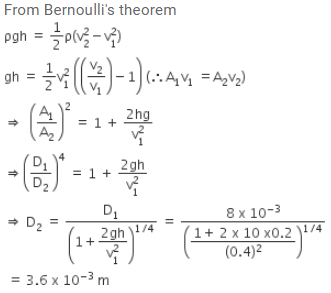
Water is flowing through a horizontal pipe in streamline flow at the narrowest part of the pipe:- a)Both pressure and the velocity remains constant
- b)velocity is maximum and pressure is minimum
- c)both the pressure and velocity are maximum
- d)both the pressure and velocity are minimum
Correct answer is option 'B'. Can you explain this answer?
Water is flowing through a horizontal pipe in streamline flow at the narrowest part of the pipe:
a)
Both pressure and the velocity remains constant
b)
velocity is maximum and pressure is minimum
c)
both the pressure and velocity are maximum
d)
both the pressure and velocity are minimum
|
|
Geetika Shah answered |
In streamline flow, the product of cross section area and velocity remains constant (equation of continuity). So in the narrowest part of the pipe velocity is maximum.
And from Bernoulli's theorem, we know that the sum of potential energy, kinetic energy and pressure energy remains constant. Since pipe is horizontal potential energy is equal at all the points. So the narrowest part of pipe pressure (pressure energy) will be minimum because velocity (kinetic energy) is maximum in the narrowest part.
And from Bernoulli's theorem, we know that the sum of potential energy, kinetic energy and pressure energy remains constant. Since pipe is horizontal potential energy is equal at all the points. So the narrowest part of pipe pressure (pressure energy) will be minimum because velocity (kinetic energy) is maximum in the narrowest part.
In which of the following types of flows is the Bernoulli’s theorem strictly applicable:- a)Streamlined and rotational
- b)Turbulent and rotational
- c)Turbulent and irrotational
- d)Streamlined and irrotational
Correct answer is option 'D'. Can you explain this answer?
In which of the following types of flows is the Bernoulli’s theorem strictly applicable:
a)
Streamlined and rotational
b)
Turbulent and rotational
c)
Turbulent and irrotational
d)
Streamlined and irrotational
|
|
Suresh Iyer answered |
Bernoulli's principle is applicable on those non-viscous liquids which have laminar flow or streamlined flow.
It means that a liquid in which its particles exert no force on each other, i.e., the speed of all the particles of the liquid is same.
Also, the liquid should travel in the form of streamlines, i.e., the liquid flowing in one pipeline (imaginary pipeline) should not mix in the liquid in another pipeline. This is called streamlined flow.
Also, turbulent flow is the opposite of streamlined flow. So, turbulent liquid will not obey Bernoulli's principle.
But if the liquid is rotated, this streamlined flow will not take place. Thus Bernoulli's principle will not be applicable to this type of liquid.
It means that a liquid in which its particles exert no force on each other, i.e., the speed of all the particles of the liquid is same.
Also, the liquid should travel in the form of streamlines, i.e., the liquid flowing in one pipeline (imaginary pipeline) should not mix in the liquid in another pipeline. This is called streamlined flow.
Also, turbulent flow is the opposite of streamlined flow. So, turbulent liquid will not obey Bernoulli's principle.
But if the liquid is rotated, this streamlined flow will not take place. Thus Bernoulli's principle will not be applicable to this type of liquid.
When the salt is added to water, the surface tension of liquid mixture will- a)Increase
- b)Depends on the quantity of water
- c)Decrease
- d)Remain unaltered
Correct answer is option 'A'. Can you explain this answer?
When the salt is added to water, the surface tension of liquid mixture will
a)
Increase
b)
Depends on the quantity of water
c)
Decrease
d)
Remain unaltered
|
|
Suresh Reddy answered |
NaCl salts cause an increase of the surface tension and the residence time of interfacial water molecules.
Force of viscosity acting on a spherical body of radius r moving with velocity v through a fluid of viscosity η is given by- a)F = 6 η v/r
- b)F = 6 π η r v
- c)F = 6 π η v
- d)F = 6 η r v
Correct answer is option 'B'. Can you explain this answer?
Force of viscosity acting on a spherical body of radius r moving with velocity v through a fluid of viscosity η is given by
a)
F = 6 η v/r
b)
F = 6 π η r v
c)
F = 6 π η v
d)
F = 6 η r v
|
|
Krishna Iyer answered |
Stoke’s Law calculates the drag force on the sphere as it travels through a fluid.
F = 6 πrηv
F = 6 πrηv
When an air bubble of radius R lies at a depth h below the free surface of a liquid of density ρ and surface tension Sla, then the excess pressure inside the bubble will be- a)

- b)

- c)

- d)

Correct answer is option 'C'. Can you explain this answer?
When an air bubble of radius R lies at a depth h below the free surface of a liquid of density ρ and surface tension Sla, then the excess pressure inside the bubble will be
a)
b)
c)
d)

|
Ambition Institute answered |
Excess pressure inside a cavity or air bubble in liquid formula
P[excess] = P[inside] - P [outside]
P [outside] =P[atm]
P[inside]= P[atm] +hpg [here p represents density] +2T/R
P[excess] = P[atm] +hpg [here p represents density] +2T/R-P[atm]
P[excess] = hpg+2T/R
Now substitute value for T
P[excess] = hpg+2S/R
Hence C is correct.
P[excess] = P[inside] - P [outside]
P [outside] =P[atm]
P[inside]= P[atm] +hpg [here p represents density] +2T/R
P[excess] = P[atm] +hpg [here p represents density] +2T/R-P[atm]
P[excess] = hpg+2T/R
Now substitute value for T
P[excess] = hpg+2S/R
Hence C is correct.
The area of cross-section of the wider tube shown in figure is 800 cm2. If a mass of 12 kg is placed on the massless piston, the difference in heights h in the level of water in the two tubes is : 
- a)10 cm
- b)6 cm
- c)15 cm
- d)2 cm
Correct answer is option 'C'. Can you explain this answer?
The area of cross-section of the wider tube shown in figure is 800 cm2. If a mass of 12 kg is placed on the massless piston, the difference in heights h in the level of water in the two tubes is :
a)
10 cm
b)
6 cm
c)
15 cm
d)
2 cm

|
EduRev JEE answered |
h × ρ × 10 = 120/800 × 10-4
h × ρ = 12/8 × 102
h × ρ = 150m
h × 1000 = 150m
h = 15cm
h × ρ = 12/8 × 102
h × ρ = 150m
h × 1000 = 150m
h = 15cm
Water is flowing in a horizontal pipe ofnon-uniform cross - section. At the most contracted place of the pipe –- a)Velocity of water will be maximum and pressure minimum
- b)Pressure of water will be maximum and velocity minimum
- c)Both pressure and velocity of water will be maximum
- d)Both pressure and velocity of water will be
minimum
Correct answer is option 'A'. Can you explain this answer?
Water is flowing in a horizontal pipe of
non-uniform cross - section. At the most contracted place of the pipe –
a)
Velocity of water will be maximum and pressure minimum
b)
Pressure of water will be maximum and velocity minimum
c)
Both pressure and velocity of water will be maximum
d)
Both pressure and velocity of water will be
minimum
minimum
|
|
Preeti Khanna answered |
Continuity equation states that, "For a non-viscous liquid and streamlined flow the volume flow rate (Area of cross section x velocity) is constant throughout the flow at any point".
According to this, Av = constant. So if at any point the cross-section area decreases then velocity of liquid at that point increases and vice-versa.
Bernoulli's equation states that, "For a streamlined and non-viscous flow the total energy (kinetic energy and pressure gradient) remains constant throughout the liquid.
According to this, kinetic energy + Pressure gradient = constant. So, if at any point the velocity increases the pressure at that point decreases and vice-versa.
At the most contracted place of the pipe area of cross section is minimum
⇒ velocity is maximum
⇒ pressure is minimum
According to this, Av = constant. So if at any point the cross-section area decreases then velocity of liquid at that point increases and vice-versa.
Bernoulli's equation states that, "For a streamlined and non-viscous flow the total energy (kinetic energy and pressure gradient) remains constant throughout the liquid.
According to this, kinetic energy + Pressure gradient = constant. So, if at any point the velocity increases the pressure at that point decreases and vice-versa.
At the most contracted place of the pipe area of cross section is minimum
⇒ velocity is maximum
⇒ pressure is minimum
What is torr?- a)Unit to measure elasticity
- b)Unit to measure adherence.
- c)Unit to measure surface tension
- d)Unit to measure pressure.
Correct answer is option 'D'. Can you explain this answer?
What is torr?
a)
Unit to measure elasticity
b)
Unit to measure adherence.
c)
Unit to measure surface tension
d)
Unit to measure pressure.
|
|
Nandini Patel answered |
The torr (symbol: Torr) is a non-SI unit of pressure with the ratio of 760 to 1 standard atmosphere, chosen to be roughly equal to the fluid pressure exerted by a millimeter of mercury, i.e., a pressure of 1 Torr is approximately equal to one millimeter of mercury. Note that the symbol is spelled exactly the same as the unit, but the symbol is capitalized, as is customary in metric units derived from names. It was named after Evangelista Torricelli, an Italian physicist and mathematician who discovered the principle of the barometer in 1644.
When wetting agents like soap or dyes are added to water, the angle of contact becomes- a)900
- b)600
- c)Large
- d)Small
Correct answer is option 'D'. Can you explain this answer?
When wetting agents like soap or dyes are added to water, the angle of contact becomes
a)
900
b)
600
c)
Large
d)
Small
|
|
Krishna Iyer answered |
When wetting agents like soap or dyes are added to water, the angle of contact becomes small. This happens so that the particles penetrate well and become effective.
A garden sprinkler has 150 small holes, each of 2 mm2 area. If water is supplied at the rate of 0.3 litres/s, then find the average velocity of the spray.- a)300 cm/s
- b)22.5 cm/s
- c)0.1 cm/s
- d)100 cm/s
Correct answer is option 'D'. Can you explain this answer?
A garden sprinkler has 150 small holes, each of 2 mm2 area. If water is supplied at the rate of 0.3 litres/s, then find the average velocity of the spray.
a)
300 cm/s
b)
22.5 cm/s
c)
0.1 cm/s
d)
100 cm/s
|
|
Neha Sharma answered |
We know by the conservation of volume we get that
0.3 L/sec = 150 x 0.02 cm2 x v
Where v is the speed of the spray,
And we know 1L = 1 cm3
Hence we get v = 150 x 0.02 cm2 / .3 cm3/s
= 100 cm2/s
0.3 L/sec = 150 x 0.02 cm2 x v
Where v is the speed of the spray,
And we know 1L = 1 cm3
Hence we get v = 150 x 0.02 cm2 / .3 cm3/s
= 100 cm2/s
Which of the following is not an application of Pascal’s Law?- a)Brahma Press
- b)Submarine
- c)Hydraulic Lift
- d)both a and c
Correct answer is option 'B'. Can you explain this answer?
Which of the following is not an application of Pascal’s Law?
a)
Brahma Press
b)
Submarine
c)
Hydraulic Lift
d)
both a and c
|
|
Anjali Iyer answered |
Applications of Pascal's law. The underlying principle of the hydraulic jack and hydraulic press. Force amplification in the braking system of most motor vehicles. Used in artesian wells, water towers, and dams.
large tank is filled with water to a height H. A small hole is made at the base of the tank. It takes T1 time to decrease the height of water to H/h, (h > 1) and it takes T2 time to take out the rest of water. If T1 = T2, then the value of h is :- a)2
- b)3
- c)4
- d)

Correct answer is option 'C'. Can you explain this answer?
large tank is filled with water to a height H. A small hole is made at the base of the tank. It takes T1 time to decrease the height of water to H/h, (h > 1) and it takes T2 time to take out the rest of water. If T1 = T2, then the value of h is :
a)
2
b)
3
c)
4
d)
|
|
Lavanya Menon answered |
t=A/a √2/g[√H1−√H2]
T1= A/a√2/g[√H1√H/η]
T2=A/a√2/g[√H/η−0]
Given, T1=T2
√H−√H/η=√H/η−0
⇒√H=2√H/η
⇒η=4
T1= A/a√2/g[√H1√H/η]
T2=A/a√2/g[√H/η−0]
Given, T1=T2
√H−√H/η=√H/η−0
⇒√H=2√H/η
⇒η=4
The angle of contact for liquid on a solid surface is the angle between:- a)the tangent to the liquid surface at the point of contact and the solid surface
- b)the tangent to the solid surface at the point of contact and the liquid surface
- c)the liquid surface and the solid surface at the point of contact
- d)none of these
Correct answer is option 'A'. Can you explain this answer?
The angle of contact for liquid on a solid surface is the angle between:
a)
the tangent to the liquid surface at the point of contact and the solid surface
b)
the tangent to the solid surface at the point of contact and the liquid surface
c)
the liquid surface and the solid surface at the point of contact
d)
none of these
|
|
Raghav Bansal answered |
The angle of contact for liquid on a solid surface is the angle between the tangent to the liquid surface at the point of contact and the solid surface. This is the definition of angle of contact.
Angle of contact of water proofing agent are generally- a)large
- b)small
- c)less then 200
- d)Can be either large or small
Correct answer is option 'A'. Can you explain this answer?
Angle of contact of water proofing agent are generally
a)
large
b)
small
c)
less then 200
d)
Can be either large or small
|
|
Jayant Mishra answered |
Generally, if the water contact angle is smaller than 90DEG, the solid surface is considered hydrophilic and if the water contact angle is larger than 90DEG, the solid surface is considered hydrophobic.
Bernoulli’s theorem is important in the field of:- a)Photoelectric effect
- b)flow of liquids
- c)Magnetism
- d)Electrical cells
Correct answer is option 'B'. Can you explain this answer?
Bernoulli’s theorem is important in the field of:
a)
Photoelectric effect
b)
flow of liquids
c)
Magnetism
d)
Electrical cells
|
|
Rohan Singh answered |
Bernoulli's theorem, in fluid dynamics, relation among the pressure, velocity, and elevation in a moving fluid (liquid or gas), the compressibility and viscosity (internal friction) of which are negligible and the flow of which is steady, or laminar.
A piece of steel has a weight W in air, W1 when completely immersed in water and W2 when completely immersed in an unknown liquid. The relative density (specific gravity) of liquid is :- a)

- b)

- c)

- d)

Correct answer is option 'B'. Can you explain this answer?
A piece of steel has a weight W in air, W1 when completely immersed in water and W2 when completely immersed in an unknown liquid. The relative density (specific gravity) of liquid is :
a)
b)
c)
d)
|
|
Preeti Iyer answered |
If the loss of weight of a body in water is 'a' while in liquid is 'b' then
Sigma in liquid / sigma in water = upthrust on body in liquid / upthrust on body in water
Then a / b = (W air - W liquid) / (W air - W water).
Sigma in liquid / sigma in water = upthrust on body in liquid / upthrust on body in water
Then a / b = (W air - W liquid) / (W air - W water).
The vertical limbs of a U shaped tube are filled with a liquid of density r upto a height h on each side. The horizontal portion of the U tube having length 2h contains a liquid of density 2r. The U tube is moved horizontally with an accelerator g/2 parallel to the horizontal arm. The difference in heights in liquid levels in the two vertical limbs, at steady state will be- a)2h/7
- b)8h/7
- c)4h/7
- d)None
Correct answer is option 'B'. Can you explain this answer?
The vertical limbs of a U shaped tube are filled with a liquid of density r upto a height h on each side. The horizontal portion of the U tube having length 2h contains a liquid of density 2r. The U tube is moved horizontally with an accelerator g/2 parallel to the horizontal arm. The difference in heights in liquid levels in the two vertical limbs, at steady state will be
a)
2h/7
b)
8h/7
c)
4h/7
d)
None
|
|
Neha Joshi answered |
Given:
a=g/2
Pressure at A
PA=Po+ρgh+(2ρ)g(h−x)=Po+3ρgh−2ρgx
Pressure at B
PB=Po+ρgx
Using
PA−PB=[2ρ(h+x)+ρ(h−x)]a
∴ (Po+3ρgh−2ρgx)−(Po+ρgx)=[3ρh+ρx]×g/2
OR 3ρgh−3ρgx=3ρgh/2+1ρgx/2
OR 3ρgh/2=7ρgx/2 ⟹x=3h/7
∴ Difference in the heights between two columns ΔH=(2h−x)−x=2h−2x
⟹ ΔH=2h−6h/7=8h/7
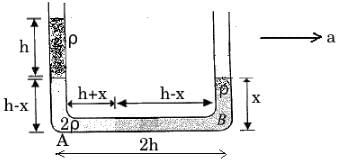
a=g/2
Pressure at A
PA=Po+ρgh+(2ρ)g(h−x)=Po+3ρgh−2ρgx
Pressure at B
PB=Po+ρgx
Using
PA−PB=[2ρ(h+x)+ρ(h−x)]a
∴ (Po+3ρgh−2ρgx)−(Po+ρgx)=[3ρh+ρx]×g/2
OR 3ρgh−3ρgx=3ρgh/2+1ρgx/2
OR 3ρgh/2=7ρgx/2 ⟹x=3h/7
∴ Difference in the heights between two columns ΔH=(2h−x)−x=2h−2x
⟹ ΔH=2h−6h/7=8h/7

A beaker containing water is placed on the platform of a spring balance. The balance reads 1.5 kg. A stone of mass 0.5 kg and density 500 kg/m3 is immersed in water without touching the walls of beaker. What will be the balance reading now ?- a)2 Kg
- b)2.5 Kg
- c)1 KG
- d)3 Kg
Correct answer is option 'B'. Can you explain this answer?
A beaker containing water is placed on the platform of a spring balance. The balance reads 1.5 kg. A stone of mass 0.5 kg and density 500 kg/m3 is immersed in water without touching the walls of beaker. What will be the balance reading now ?
a)
2 Kg
b)
2.5 Kg
c)
1 KG
d)
3 Kg
|
|
Suresh Reddy answered |
Since the weight of the block must be equal to the buoyant force acting on the block for it to remain in equilibrium,
B=0.5kg
The reading of the spring balance = Weight of water + Buoyant force' reaction pair force downwards
=1.5kg+0.5kg=2kg
A boy carries a fish in one hand and a bucket (not full) of water in the other hand. If the places the fish in the bucket, the weight now carried by him (assume that water does not spill) :- a)Is less than before
- b)Is more than before
- c)Is the same as before
- d)Depends upon his speed
Correct answer is option 'C'. Can you explain this answer?
A boy carries a fish in one hand and a bucket (not full) of water in the other hand. If the places the fish in the bucket, the weight now carried by him (assume that water does not spill) :
a)
Is less than before
b)
Is more than before
c)
Is the same as before
d)
Depends upon his speed
|
|
Gaurav Kumar answered |
Buoyant force on fish due to water will be equal and opposite to the force on water by fish.
These two forces are internal forces for the fish bucket system.
Hence, they will not affect the weight the boy carries.
These two forces are internal forces for the fish bucket system.
Hence, they will not affect the weight the boy carries.
A wooden block, with a coin placed on its top, floats in water as shown in figure. The distances l and h are shown there. After some time the coin falls into the water. Then

- a) l decreases and h increases
- b)l increases and h decreases
- c)both l and h increase
- d)both l and h decrease
Correct answer is option 'D'. Can you explain this answer?
A wooden block, with a coin placed on its top, floats in water as shown in figure. The distances l and h are shown there. After some time the coin falls into the water. Then


a)
l decreases and h increases
b)
l increases and h decreases
c)
both l and h increase
d)
both l and h decrease
|
|
Vaishnavi answered |
The coin will be fall in water , the total length of wood and coin is l so the coin fall into the water length is decrease and total height also decrease
A light semi cylindrical gate of radius R is piovted at its mid point O, of the diameter as shown in the figure holding liquid of density r. The force F required to prevent the rotation of the gate is equal to
- a) 2pR3rg
- b)2rgR3l
- c)

- d)None of these
Correct answer is option 'D'. Can you explain this answer?
A light semi cylindrical gate of radius R is piovted at its mid point O, of the diameter as shown in the figure holding liquid of density r. The force F required to prevent the rotation of the gate is equal to
a)
2pR3rg
b)
2rgR3l
c)
d)
None of these
|
|
Raghav Bansal answered |
The force is normal to the surface of the cylinder and hence will pass through the centre. And since the forces pass through the centre it means that the net torque will be zero.
The liquid that does not wet the solid surface has an ______ angle of contact.- a)900
- b)acute
- c)obtuse
- d)600
Correct answer is option 'C'. Can you explain this answer?
The liquid that does not wet the solid surface has an ______ angle of contact.
a)
900
b)
acute
c)
obtuse
d)
600
|
|
Mira Sharma answered |
When liquid molecules are attracted strongly to themselves and weakly to those of solids, it costs lots of energy to create liquid-solid surface and liquid then does not wet the solid.
For Example:
Mercury molecules (which make an obtuse angle with glass) have a strong force of attraction between themselves and a weak force of attraction toward solids. Hence, they tend to form drops.
On the other hand, water molecules make acute angles with glass. They have a weak force of attraction between themselves and a strong force of attraction toward solids. Hence, they tend to spread out.
In the figure shown, the heavy cylinder (radius R) resting on a smooth surface separates two liquids of densities 2r and 3r. The height `h' for the equilibrium of cylinder must be 
- a)3R/2
- b)

- c) R√2
- d)None
Correct answer is option 'B'. Can you explain this answer?
In the figure shown, the heavy cylinder (radius R) resting on a smooth surface separates two liquids of densities 2r and 3r. The height `h' for the equilibrium of cylinder must be
a)
3R/2
b)
c)
R√2
d)
None
|
|
Om Desai answered |
First, let’s concentrate on the force exerted by the liquid of density 3ρ on the cylinder in the horizontal direction.
Let the length of the cylinder be L.
Consider a small segment of length rdθ at an angle θ from the horizontal line.
Height of this segment from the topmost point of fluid 3ρ is R sinθ
Hence, the pressure exerted by the fluid will be 3ρgRsinθ
The force exerted in the horizontal direction, dF=3ρgRsinθRLcosθdθ
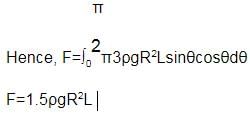
Similarly, proceeding for the fluid with density 2ρ
Height of any segment, above horizontal =h−R−Rsinθ
below horizontal, h−R+Rsinθ
Thus, horizontal force on the cylinder because of fluid,

For equilibrium, both the forces should be equal, hence solving the above equation,
h = R √3/2
Let the length of the cylinder be L.
Consider a small segment of length rdθ at an angle θ from the horizontal line.
Height of this segment from the topmost point of fluid 3ρ is R sinθ
Hence, the pressure exerted by the fluid will be 3ρgRsinθ
The force exerted in the horizontal direction, dF=3ρgRsinθRLcosθdθ

Similarly, proceeding for the fluid with density 2ρ
Height of any segment, above horizontal =h−R−Rsinθ
below horizontal, h−R+Rsinθ
Thus, horizontal force on the cylinder because of fluid,

For equilibrium, both the forces should be equal, hence solving the above equation,
h = R √3/2
A cylindrical drum, open at the top, contains 30 litres of water. It drains out through a small opening at the bottom.10 litre of water comes out in time t, the next 10 litres in a further time t2 and the last 10 litres in a further time t3.Then- a)t1 = t2 = t3
- b)t1> t2 > t3
- c)t1 < t2 < t3
- d)t2> t1 = t3
Correct answer is option 'C'. Can you explain this answer?
A cylindrical drum, open at the top, contains 30 litres of water. It drains out through a small opening at the bottom.10 litre of water comes out in time t, the next 10 litres in a further time t2 and the last 10 litres in a further time t3.Then
a)
t1 = t2 = t3
b)
t1> t2 > t3
c)
t1 < t2 < t3
d)
t2> t1 = t3
|
|
Hansa Sharma answered |
We know that,
Velocity of efflux is given as v = √2gh
As the water level in the tank decreases, the velocity with which water comes out from the opening decreases due to decrease in pressure with height. Hence, the time taken to empty the tank increases with decrease in velocity and height of water level.
Hence C is the correct answer.
Velocity of efflux is given as v = √2gh
As the water level in the tank decreases, the velocity with which water comes out from the opening decreases due to decrease in pressure with height. Hence, the time taken to empty the tank increases with decrease in velocity and height of water level.
Hence C is the correct answer.
When impurity is added to a liquid, its surface tension- a)decreases
- b)first decreases and then increases
- c)increases
- d)remains same
Correct answer is option 'A'. Can you explain this answer?
When impurity is added to a liquid, its surface tension
a)
decreases
b)
first decreases and then increases
c)
increases
d)
remains same
|
|
Arun Khanna answered |
When impurities are mixed in liquid, surface tension of liquid decreases. The soluble substances when dissolved in water, decreases the surface tension of water.
Chapter doubts & questions for Mechanical Properties of Fluids - Physics for Grade 11 2025 is part of Grade 11 exam preparation. The chapters have been prepared according to the Grade 11 exam syllabus. The Chapter doubts & questions, notes, tests & MCQs are made for Grade 11 2025 Exam. Find important definitions, questions, notes, meanings, examples, exercises, MCQs and online tests here.
Chapter doubts & questions of Mechanical Properties of Fluids - Physics for Grade 11 in English & Hindi are available as part of Grade 11 exam.
Download more important topics, notes, lectures and mock test series for Grade 11 Exam by signing up for free.
Physics for Grade 11
83 videos|253 docs|174 tests
|

Contact Support
Our team is online on weekdays between 10 AM - 7 PM
Typical reply within 3 hours
|
Free Exam Preparation
at your Fingertips!
Access Free Study Material - Test Series, Structured Courses, Free Videos & Study Notes and Prepare for Your Exam With Ease

 Join the 10M+ students on EduRev
Join the 10M+ students on EduRev
|

|
Create your account for free
OR
Forgot Password
OR
Signup to see your scores
go up
within 7 days!
within 7 days!
Takes less than 10 seconds to signup

